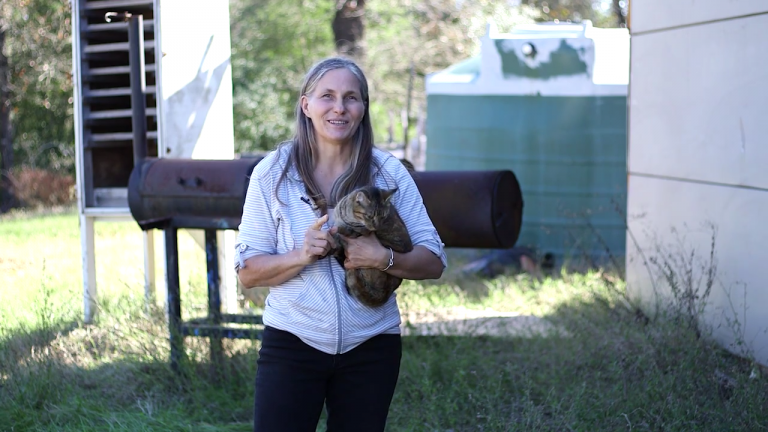This is Marjory Wildcraft. On this edition of Homesteading Basics, we’re going to talk about the perfect camouflage for barn cats.
This one is really going to surprise you.
You all have met Tigger the barn cat in previous episodes of Homesteading Basics. Tigger is a tabby cat, and she just blends in so perfectly with the grass. Actually, the first time I set her down on that grass, I just saw this recognition in the cat that she knew her purpose and place in life. It was just a beautiful moment.
Tigger is a tabby, so obviously she has really good camouflage for this environment.
The Best Camouflage For Barn Cats
I also want to introduce you to Valerie the big, fat house cat. She actually has surprisingly good camo, too. We got Valerie when she was about half grown. She was a pound kitty. She was severely addicted to cheap cat food. As much as I gave her really good, high quality meats and things, she would never stop eating the cheap cat food. This is what happens to you when you eat cheap food.
She’s gotten real big, but let’s talk about her camouflage.
First of all, Valerie is a calico. She’s got these colors that are just very pleasing to human beings. We love looking at her. She’s so fun and colorful, though, that I was concerned. We live out here with owls, coyotes, and other predators, and I thought that her visibility would get her eaten. Actually, it turns out that the way her colors are organized, she’s very, very safe—even though almost anything can see her. When you look at her from above or from the side, it’s very difficult to tell where her head is or where her tail is.
Confusing Predators With Camouflage
One of the things about predators is that they’re very, very careful before they attempt to kill. A predator’s life depends upon its body and its ability to move. If there’s any possibility that it’s going to hurt itself during a hunt—like by attacking a rear end when it thought it was the front end—then it won’t do it.
Valerie has survived out here for many, many years with impunity, and it’s primarily got to do with her camouflage. She’s got double camouflage in that it’s cute and pleasing to humans, and it’s also successful against predators.
Marjory Wildcraft is an Expedition Leader and Bioneer Blogger with The [Grow] Network, which is an online community that recognizes the wisdom of “homegrown food on every table.” Marjory has been featured as an expert on sustainable living by National Geographic, she is a speaker at Mother Earth News fairs, and is a returning guest on Coast to Coast AM. She is an author of several books, but is best known for her “Grow Your Own Groceries” video series, which is used by more than 300,000 homesteaders, survivalists, universities, and missionary organizations around the world.









COMMENTS(8)
So what exactly is the tip here? To select cats by their fur color? I have 40+ cats (all neutered) and I was hopping for a real suggestion here.
We could use a good mouser. I am allergic to cats, so it would need to live outside. We don’t have a barn. I am wondering what kind of shelter we would need to give our cat in Zone 3, where we get into the -30 to -35F range a few nights a year, and periods of a few days to two weeks of sub-zero with high wind. Except this year, when we get alternating cold and 0F-ish freeze. Among other things, I suspect this will make for a robust population of mice this spring and a robust annual fall invasion without a reliable predator. Other questions: Are female cats better that males for this purpose, especially if neutered? We have on the ground predators like fishers, coyotes, wolves, in addition to hawks, owls and eagles. It is amazing about Valerie’s survival skill! A feral cat cruises through here once in a while. Would this be a big risk to our homestead staff kittY. How do we gauge how much to feed it? Just offer food and take note of complaints?
Fishers, coyotes, wolves, owls, hawks, and eagles all eat mice. If you made a shelter for the feral cat, one that kept him out of the elements and allowed him to keep warm, plus provided him with daily food and water, he might consider staying more frequently at your place. If he’s a male, he’s more likely to roam than a female.
For a shelter, if you can make one like the size of a large covered litter box where he can get in and out easily, but also have it insulated so he can keep warm, i.e. his body heat would be retained around him, that should work. Something like a few straw bales around the enclosed kitty box would help. Neighbours of mine had feral cats live under their deck quite happily, although in that location, we were Zone 5.
Other good mousers are snakes or chickens. Obviously when the weather got really cold the snakes would go into hiding, and chickens would need some care and protection from predators.
Thanks, Megan! Plenty of ideas to work with here. Had a good laugh when I realized how important a role my organic garden plays in supporting the wildlife out here! Raw, no chemicals and non-GMO, too! I think I have seen litter boxes with covers. They are a little bit like a cat carrier. I’m guessing the entrance will be enhanced by a little protection. I think cats have pretty good sight, hearing and smell. Is it important to them to be able to have an unobstructed view from their shelter? I figure they are so agile that they could get in and out even the entrance were partially screened. Should I face the opening towards and a few inches back from my 2×4 welded wire garden fence? This would be an easy spot to pile with straw bales.
A note about small dogs in rural areas: Where we are, coyotes lure them away from home and eat them. I’ve had friends with German Shepherd size dogs who have similarly lost them to wolves and possibly coyotes. For some reason, they often leave the heads and entirely make off with the rest. I’m thinking it may be the tick collars. For whatever reason, it must be a shock to find while hunting for a lost pet.
If allergic to cats, perhaps a rat terrier would work for you as a mouser. But you would have to keep it in the house because they aren’t camouflaged and are subject to attack by other predators.
have any of you guys purchased or seen this product I am trying to build a tiny home as off grid as possible need all the help I can get.
Click Here!
Shelli’s link locked me into a 5 min. or so sales pitch for what looks like a solar energy system that generates income form the utilities service. It was annoying and for darn sure had nothing to do with cats! Many municipalities do not a solar energy grid purchase option, and some states, ex. Hawai’i have quit offering it, often because too many residents quit using other forms of electric power.. It focuses on a power and heat loss in a Wisconsin winter. Where I am in Zone 3, solar power is unlikely to save us from -30F for a week or even 20F for a week. Solar energy requires a good technical knowledge of how your system works, whether you hire a consultant to tell you what to or buy, or you research it yourself. Best compendium resource for a small-footprint lifestyle is permies.com where you will find extensive discussion and instructions for Rocket Mass Heaters, solar power tech basics and leading edge, a lot of alternative energy and earthworks options, tiny house ideas and the other big self-sufficiency criteria: growing your own food in many ecosystems, altitudes, challenging terrain. Marjory Wildcraft is featured often! About any topic that has come up in the permaculture exploration is addressed or referenced at permies.com..
I have a jack Russell rat terrier she destroys all rodents in quick work.